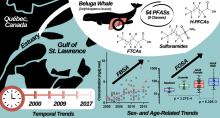| Title | Sono-chemical treatment of per- and poly-fluoroalkyl compounds in aqueous film-forming foams by use of a large-scale multi-transducer dual-frequency based acoustic reactor. |
| Publication Type | Journal Article |
| Year of Publication | 2018 |
| Authors | Gole, VL, Sierra-Alvarez, R, Peng, H, Giesy, JP, Deymier, P, Keswani, M |
| Journal | Ultrason Sonochem |
| Volume | 45 |
| Pagination | 213-222 |
| Date Published | 2018 Jul |
| ISSN | 1873-2828 |
| Abstract | Aqueous film-forming foams (AFFFs) contain a mixture of organic chemicals, including per- and poly-fluorinated, alkyl sulfonate substances (PFAS) (1-5%, w/w). Some longer-chain PFAS can be toxic, moderately bioaccumulative and persistent in the environment. In the present work, decomposition of PFAS present in two commercially available AFFFs (ANSUL- and 3M-) was investigated using a sono-chemical reactor of volume 91 L. The reactor consists of 12 transducers with operating frequencies of 1 MHz or 500 kHz and total input power of 12 kW. Degradation of PFASs performed using various dilutions of AFFF revealed that release of F and SO ions was inversely proportional to initial pH of up to 4. Defluorination of ANSUL-AFFF resulted in an increase in the concentration of F released from 55.6 ± 0.3 µM (500× dilution) to 58.6 ± 0.6 (25× dilution), while for 3M AFFF it increased from 19.9 ± 0.7 µM (500× dilution) to 217.1 ± 2.4 µM (25× dilution). Though amounts of F released were less for ANSUL-AFFF than for 3M-AFFF, there was a considerable increase in removal of TOC and release of SO present in ANSUL-AFFF. Approximately 90.5% and 26.6% reduction of perfluoroalkyl sulfonates (PFSA) and perfluoroalkyl carboxylates (PFCA) in 3M, respectively, and 38.4% reduction of fluorotelomer sulfonates in ANSUL-AFFF were achieved in 13 h. Estimated costs of energy for the treatment of ANSUL-AFFF and 3M-AFFF at a 500× dilution were $0.015 ± 0.0001/L and $0.019 ± 0.0002/L, respectively. |
| DOI | 10.1016/j.ultsonch.2018.02.014 |
| Alternate Journal | Ultrason Sonochem |
| PubMed ID | 29705315 |
Environmental Chemical Biology

